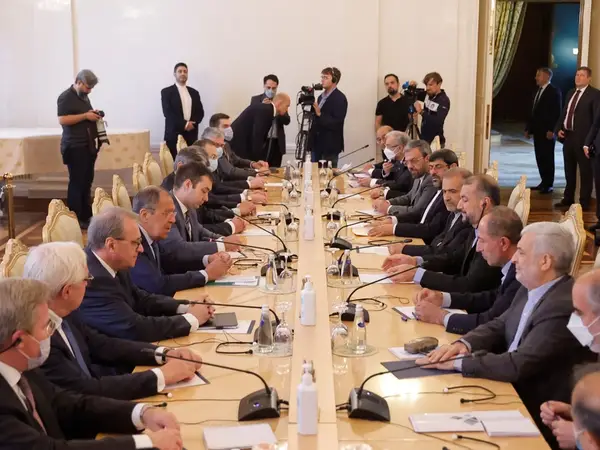Moscow and Tehran are working on a 20-year strategic cooperation deal, foreign minister Sergei Lavrov said during a press conference with his Iranian counterpart.
Tehran’s top diplomat, Hossein Amir-Abdollahian, met Lavrov in Moscow on Wednesday and discussed an array of foreign policy issues, but also more economic cooperation, as both are under international banking and energy sanctions.
Iran is currently negotiating with the West to resolve disputes around its nuclear program and emerge form crippling US sanctions, leading to concerns that Russia might use Iran to circumvent some international sanctions.
Despite a lot of rhetoric about close relations, bilateral trade between the two countries is quite small, only recently reaching $4 billion. The reason for this is that Russia until its invasion of Ukraine had a trade oriented toward the West and China, rather than Iran. Russian consumers could afford Western goods and China, Vietnam and others filled the void for cheaper merchandise.
But that can somewhat change. Lavrov mentioned plans to launch a free trade zone with Iran and the two allies have been holding talks with Azerbaijan to have a trade corridor from north to south. Still, Russia can benefit more from trade with Turkey since the latter has not joined Western sanctions.
Another project is for Iran to join Russia’s Mir payment system, launched in 2017 after the first Western sanctions following Moscow’s occupation of Crimea in 2014. The central bank launched the National Card Payment System after 2014, which issued the Mir payment system later. Both Russia and Iran are cut off from Mastercard and Visa, and Iran is completely banned from the Western banking communication system SWIFT, while also some Russian banks were disconnected from the fast money transfer service in March.
The Mir system itself is now contained, by around 100 million cardholders only having access to their Russian bank accounts and unable to do transactions with ecommerce websites elsewhere, except a few former Soviet Republics that are also members of the payment system.
But if Iran reaches a nuclear deal and US sanctions are lifted, its banking ties with other countries might gradually improve. In that case, Russians can use the Mir system to conduct international transactions via Iran.
Hadi Tizhush Taban, chairman of Russia Iran chamber of commerce in Tehran told a local website on Wednesday that Iran had only 0.5 percent of Russia’s international trade share before the invasion of Ukraine. He urged the development of trade infrastructure between the two counties, which itself might take a long time.
Taban expressed optimism that if a new nuclear deal is reached and sanctions lifted, Iran can have more non-oil exports to Russia.
But the biggest bonanza for Moscow would be its $10 billion deal with Tehran to expands nuclear power in Iran. The United States has reportedly agreed to allow Russia to continue with this project, which many think will be an opportunity for Moscow to circumvent Western sanctions.
Iran also has plans to import natural gas from Russia ostensibly as “swap” deal, but none of Iran’s neighbors except Turkey are Russian gas customers. In reality, Iran wants to use Russian gas to compensate for its domestic shortage and use the supply to sell more gas to Iraq and perhaps Pakistan as a new customer.
Despite all the talk about vastly expanding economic ties, Russia and Iran remain rivals in the oil market and their cooperation is more significant in political and military spheres.
